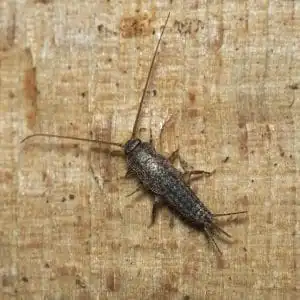Considered a household nuisance, silverfish (Lepisma saccharina) are easily recognized by their slim gray bodies. If you spot one once in awhile under the sink or in the basement, don’t worry. These nocturnal creatures are not dangerous. They don’t bite and aren’t known to spread diseases. However, in large numbers they damage paper products like wallpaper and boxes, and feast on foods heavy in starch. No one wants an infestation of these pests, so here’s what you can do to eliminate and prevent silverfish from making your home their hangout.
Identification
Slender slinky bodies that are shiny and silvery gray in color give these bugs their name. Ranging from a quarter inch to half an inch long, the flat bodies are larger at the head and taper off at the rear. They have three pairs of legs, two antennae, and three long bristly hairs at the rear. Silverfish are hard to catch because they wriggle rapidly across surfaces.
Silverfish have a strange starchy diet and like to dine on papery substances like books, boxes, photos, magazines, and wallpaper glue. They also eat certain fabrics and love foods high in carbs like flour, bread, sugar, and cereal. No accounting for taste, these gross creatures also enjoy mold and dead skin cells and can survive a long time without food.
Signs and Symptoms
Usually, silverfish enter homes through cracks or crevices, but sometimes grab a ride inside boxes or bags. They like dark, damp, or humid areas and can often be found in bathrooms, basements, and underneath kitchen sinks, especially if there are leaky pipes. During the day they hide, but nighttime is feeding time. They sometimes leave behind yellowish stains or loose scales as they roam.
Elimination
There are some natural methods to capture these quick moving creatures. You can make your own traps using a glass jar, masking tape, and a piece of bread. Silverfish use the tape to climb up the jar, but once they fall in, they can’t climb back out on the smooth surface of the jar’s interior. They are trapped inside!
Cedar oil is a substance these pests avoid. Try spraying it in cracks and crevices or under sinks. Diatomaceous dirt and boric acid are natural ways to poison these pests, but should be used sparingly around children and pets. If you have a serious infestation, a pesticide may be necessary. It’s best to call in an expert for chemical applications.
Prevent Silverfish
After you’ve eliminated these creatures in your home, there are steps to take to prevent a recurring infestation.
- Fix leaky pipes and faucets.
- Use dehumidifiers in damp basements.
- Fill in cracks and crevices along floorboards, walls, windows, and doors.
- Clean or vacuum under sinks and along floorboards, concentrating on nooks and crannies.
- Get rid of old boxes and piles of newspapers.
- Store unused books, papers, magazines, clothes, and photo albums in sealed plastic containers.
- Make sure containers or packages of food are tightly closed and crumbs are cleaned up regularly.
Call the Experts
It’s best to use natural methods to prevent silverfish first, but chemicals may be necessary for infestations. Since the chemicals are dangerous, they should be safely applied by a professional. If you suspect a pest infestation in your home or wish to take preventative measures, contact Free Spray Lawn Care today at 419-529-5296.



Comments (0)
Thanks for your comment!
Thanks for your feedback! Your comments have been successfully submitted! Please note, all comments require admin approval prior to display.
Error submitting comment!
There is a problem with your comment, please see below and try again.